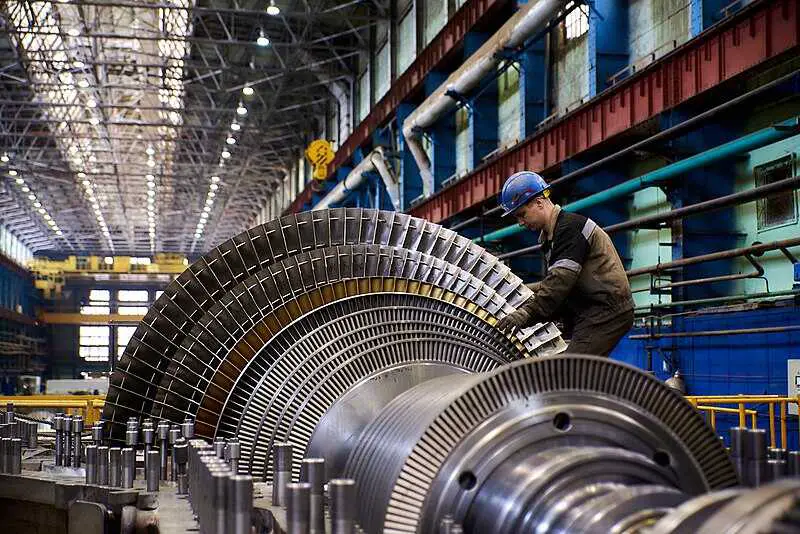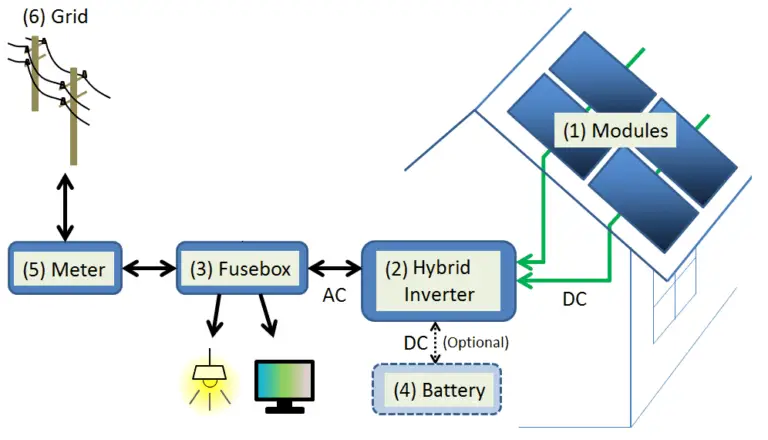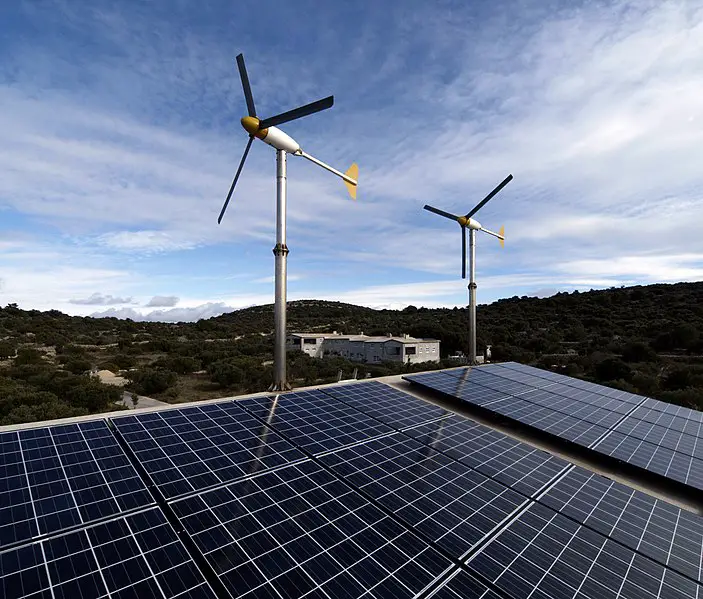7 Steam Turbine Parts and Functions Explained
Steam turbine parts are; casing, rotor, blades, bearings, seals, governor system, and support system.
This article discusses steam turbine parts and functions, as follows;
1). Casing (as one of the Steam Turbine Parts)
The main function of the turbine casing is to prevent leakage of the working fluid from the turbine assembly.
Casings of steam turbines are usually split in a horizontal direction, to allow for easy access in case of system maintenance and repair.
Materials used for steam turbine casing are generally those having high thermal and mechanical resilience including cast iron and low-carbon steel alloys.
These materials are used in order to withstand the high temperatures of above 300° C, of steam that enters the turbine assembly [4].
2). Rotor
The rotor in a steam turbine is the main movable component that enables the turbine to produce mechanical energy from steam pressure.
It is the core to which other components like the blades are attached to form the rotor assembly.
A steam turbine rotor is made by assembling concentric layers of cylindrical sub-components that may be referred to as cylinders, runners or shafts, which form the movable rotary core of the turbine. These sub-components are usually made from materials whose thermo-physical properties such as expansivity, are suited to the temperature and pressure conditions of steam.
Types of turbine rotors include; rigid, flexible, disk and drum rotors, which are classified on the basis of basic design and spatial configuration [2].
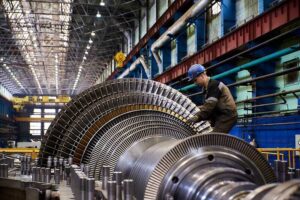
3). Blades (as one of the Steam Turbine Parts)
Blades are one of the most important components of a steam turbine.
The function of steam turbine blades is to capture the pressure and velocity of steam, and to convert these to rotary mechanical energy. Blades are therefore a major part of the rotor assembly, which is responsible for thermo-mechanical conversion.
The types of turbine blades, especially with regards to steam turbines, are; movable blades and fixed blades. The fixed blades differ from movable blades in their geometry and mechanical configuration, and are often referred to as 'nozzles'.
In several types of steam turbines, movable blades occur alongside fixed blades. This is the case for impulse turbines. The combination of fixed and movable blades is done to increase energy efficiency and minimize wastage of energy of steam that comes in contact with the turbine rotor.
Blade design is one of the most critical components that determines the overall operation of the steam turbine [8].
4). Bearings
A bearing in a turbine is one of several small-sized components that are used to minimize friction between moving parts like the rotor blade-core and the shafts, as well as to optimize rotation and efficiency.
Types of bearings used in turbines include roller bearings and ball bearings, which differ in the geometry and locomotive mechanism of the bearing components.
Bearings are usually lubricated with an oil-film for friction minimization [6]. The design and type of bearing used in any turbine depends on specific design attributes [1].
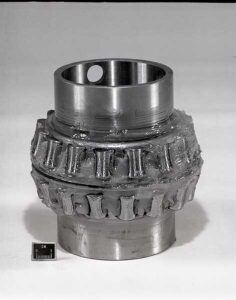
Steam Turbine Parts: Bearings (Credit: National Aeronautics and Space Administration. John H. Glenn Research Center at Lewis Field. 3/1/1999. 1973-2013)
5). Seals (as one of the Steam Turbine Parts)
Seals are secondary components of steam turbines, whose main function is to seal the working fluid (steam) within the system, and prevent it from escaping, especially from areas between sub-components and stages of the turbine.
The purpose of sealing steam in the turbine is to optimize efficiency, since a loss of steam will result in losses of thermal energy, undesired thermal expansion, and slower rates of mechanical rotation. Basically, seals are made to fill the possible exit areas and minimize steam leakage [7].
Types of seals used in turbines include blade, rotor, gland, radial, axial, shaft, root, tip, end, diaphragm, and shroud seals [5]. There is no definite classification or number of types of turbine seals, and the types distinguished are defined by various different factors like location of use, component of use and pattern of use.
6). Governor System
Governor system in steam turbines is a regulatory component that is used to alter the rotational speed of the turbine to suit existing needs and conditions.
The function of the governor in a steam turbine is to detect rotation speed, and ensure that this speed is in equilibrium with external factors such as electrical load, by altering the rate and direction of steam flow with respect to the turbine rotor.
Methods of governing in steam turbines are flow-rate governing and flow-direction governing.
Types of governor systems in steam turbines include electrical, mechanical and hydraulic types; which can be combined to produce electro-mechanical and electro-hydraulic governors, among others.
Governor systems can be modified and retrofitted as needed, to improve turbine regulation [3].
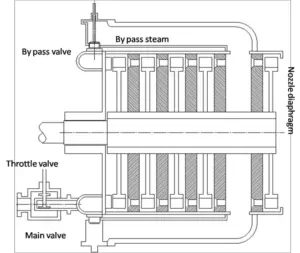
7). Support System (as one of the Steam Turbine Parts)
Support system in a steam turbine is an assemblage of multiple sub-components that are designed to complement the role(s) of other components and improve the overall efficiency of the system.
The function of turbine support system includes lubrication, steam sealing and flow-control.
Conclusion
Steam turbine parts are;
1. Casing
2. Rotor
3. Blades
4. Bearings
5. Seals
6. Governor System
7. Support System
References
1). DeCamillo, S. M.; Dadouche, A.; Fillon, M. (2013). "Thrust Bearings in Power Generation." In: Wang, Q.J., Chung, YW. (eds) Encyclopedia of Tribology. Springer, Boston, MA. Available at: https://doi.org/10.1007/978-0-387-92897-5_57. (Accessed 3 March 2023).
2). Kaneko, Y.; Kanki, H.; Kawashita, R. (2017). "Steam turbine rotor design and rotor dynamics analysis." Advances in Steam Turbines for Modern Power Plants (pp.127-151). Available at: https://doi.org/10.1016/B978-0-08-100314-5.00007-5. (Accessed 3 March 2023).
3). Lamberson, J. S. (1999). "Steam Turbine Governing Systems And Electronic Governor Retrofit." Available at: https://www.semanticscholar.org/paper/Steam-Turbine-Governing-Systems-And-Electronic-Lamberson-Reed/8202956698a74ed2797266ad34b7c4eccf14b901. (Accessed 3 March 2023).
4). Laxminarayan, K.; Jayanth, H. S.; Reddy, C. M. (2014). "Design and Analysis of High-pressure Casing of a Steam Turbine." Procedia Materials Science, Volume 5, 2014, Pages 1745-1754. Available at: https://www.sciencedirect.com/science/article/pii/S2211812814007299. (Accessed 3 March 2023).
5). Neuimin, V. M. (2018). "Steam Turbine Flow Path Seals (a Review)." Therm. Eng. 65, 125–135 (2018). Available at: https://doi.org/10.1134/S0040601518030059. (Accessed 3 March 2023).
6). Pennacchi, P. (2017). "Introduction of advanced technologies for steam turbine bearings." Advances in Steam Turbines for Modern Power Plants (pp.321-380). Available at: https://doi.org/10.1016/B978-0-08-100314-5.00015-4. (Accessed 3 March 2023).
7). Tanuma, I.; Tominaga, J. (2022). "15 - Sealing designs and analyses for steam turbines." Advances in Steam Turbines for Modern Power Plants (Second Edition), Woodhead Publishing Series in Energy, 2022, Pages 359-382. Available at: https://doi.org/10.1016/B978-0-12-824359-6.00025-1. (Accessed 3 March 2023).
8). Zhu, M. (2019). "Design and analysis of steam turbine blades." Journal of Physics Conference Series 1300(1):012056. Available at: https://doi.org/10.1088/1742-6596/1300/1/012056. (Accessed 3 March 2023).
